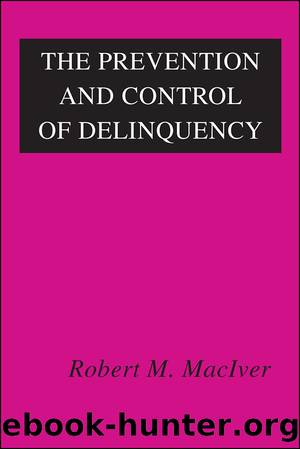The Prevention and Control of Delinquency by Jennifer Schrock

Author:Jennifer Schrock [Schrock, Jennifer]
Language: eng
Format: epub
ISBN: 9780202361604
Barnesnoble:
Publisher: Transaction Publishers
Published: 2007-12-15T00:00:00+00:00
Some Special-Objective Programs
Much of the service the school can render in the prevention of delinquency is at the same time beneficial to all school children. This applies, for example, to guidance programs, whether specifically for educational guidance or for behavioral or vocational guidance, and also in considerable measure to reading instruction. Special remedial reading courses are necessary for those whose reading ability is abnormally low. It is our conviction, based on considerable experience, that reading standards are generally far too low, and that much more attention should be given in teacher training and in curricular adaptations to raise the over-all level of this most essential instruction.
Among more specialized programs we place first and foremost that of early identification of problem children. Programs of this type are still far too few. It is the most obvious of principles, but in this field one is tempted to say the least regarded, that the earlier any trouble is located and diagnosed the greater the chance that treatment will effect a cure. Most commonly recognized is the âacting outâ youngster who is noisy and fractious. But there may be serious maladjustment gnawing at children who are recessive and introvert or at most sulky. It requires patience and skill to discover the problems of children, and teachers no less than guidance counselors should be taught the symptoms. Discovery is, of course, only the beginning; it must be followed by early care. The principal of a New York City school once told the writer about one or two students who in later years were involved in felonies. She said she reported the matter early in the elementary school history of the cases, but the only action taken was a filed report, with no follow-up, indicating minor adjustment difficulties. This, we should add, happened a decade ago, and important developments have taken place in this school system since then. The kindergarten and first years of elementary schooling represent the stage at which identification of trouble should begin, as has been pointed out, for example, in a study under the Santa Barbara school system, and as leading authorities, such as Dr. Marion Kenworthy, have insisted.
New York City a few years ago inaugurated an early identification program for kindergarten and the first three grades, with emphasis on the second grade. It is significant that first-grade teachers indicated that from 85 to 90 per cent of the children given attention had both learning problems and social or emotional problems, reading difficulties being most apparent.18 Another program for the elementary school, the junior guidance program, provides special classes through grades 2 to 6 for disturbed children who fail to respond to classroom teaching. Attached to the program are full-time counselors and therapists. Specially trained teachers are also provided. The counselors focus on the relation of parents to children, since so often the disturbance of the child has its root in the home situation.19 In still another program therapeutic play groups (led by specially trained guidance counselors) are set up and function as a guidance service to a limited number of elementary schools.
Download
This site does not store any files on its server. We only index and link to content provided by other sites. Please contact the content providers to delete copyright contents if any and email us, we'll remove relevant links or contents immediately.
The Secret History by Donna Tartt(18075)
The Social Justice Warrior Handbook by Lisa De Pasquale(11940)
Thirteen Reasons Why by Jay Asher(8414)
This Is How You Lose Her by Junot Diaz(6408)
Weapons of Math Destruction by Cathy O'Neil(5798)
Zero to One by Peter Thiel(5456)
Beartown by Fredrik Backman(5303)
The Myth of the Strong Leader by Archie Brown(5214)
The Fire Next Time by James Baldwin(4997)
How Democracies Die by Steven Levitsky & Daniel Ziblatt(4940)
Promise Me, Dad by Joe Biden(4897)
Stone's Rules by Roger Stone(4829)
100 Deadly Skills by Clint Emerson(4659)
Rise and Kill First by Ronen Bergman(4535)
A Higher Loyalty: Truth, Lies, and Leadership by James Comey(4530)
The David Icke Guide to the Global Conspiracy (and how to end it) by David Icke(4358)
Secrecy World by Jake Bernstein(4354)
The Farm by Tom Rob Smith(4303)
The Doomsday Machine by Daniel Ellsberg(4230)
